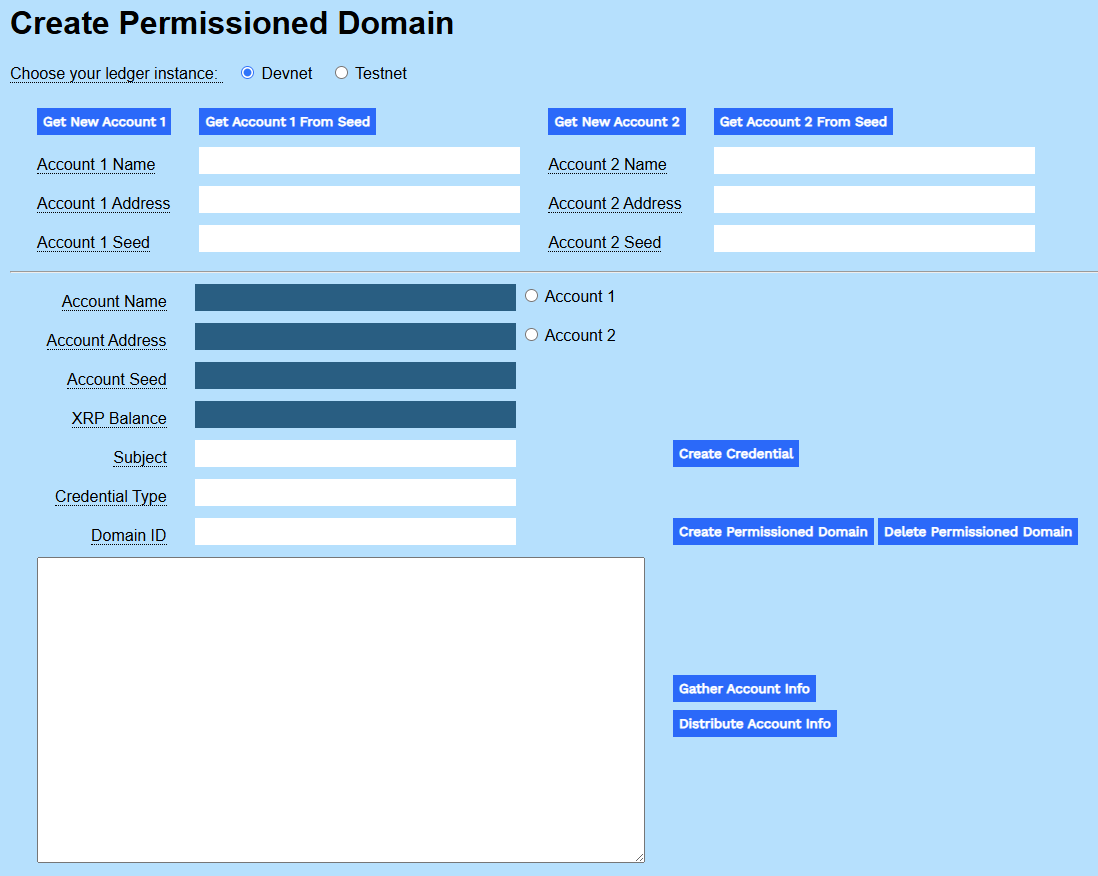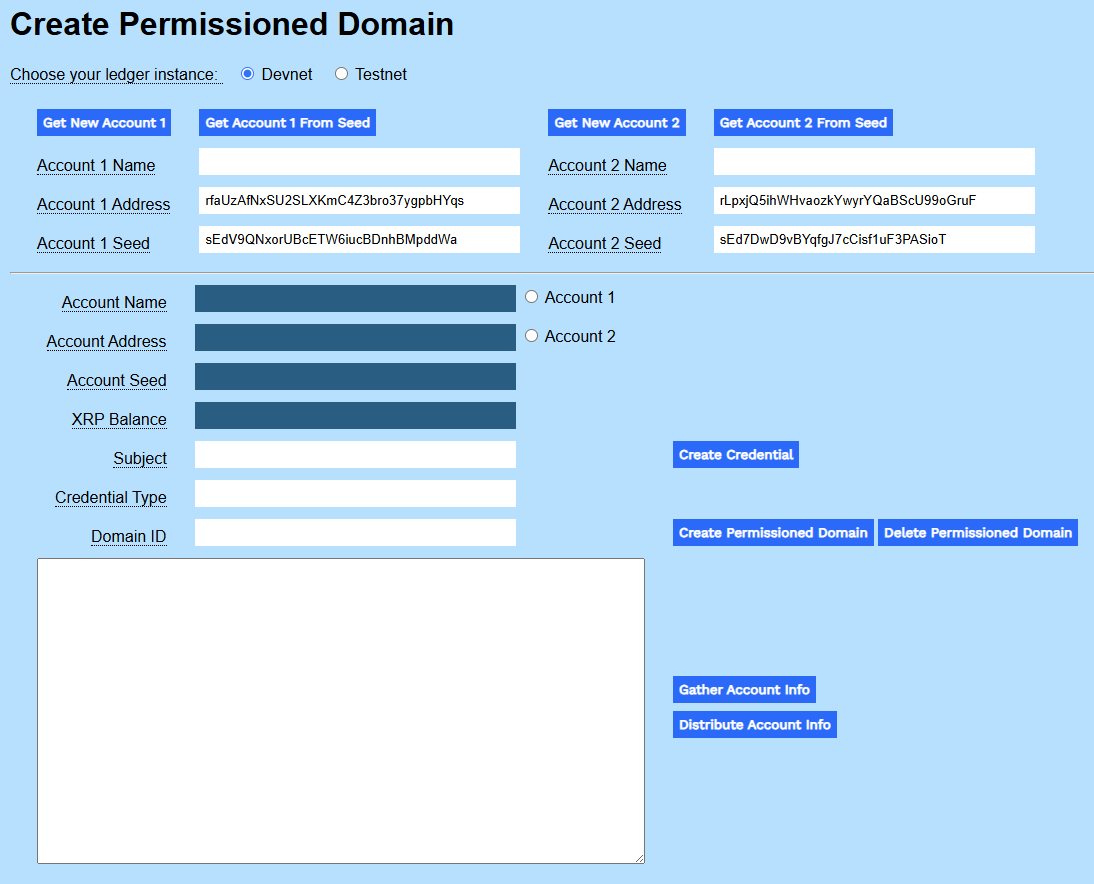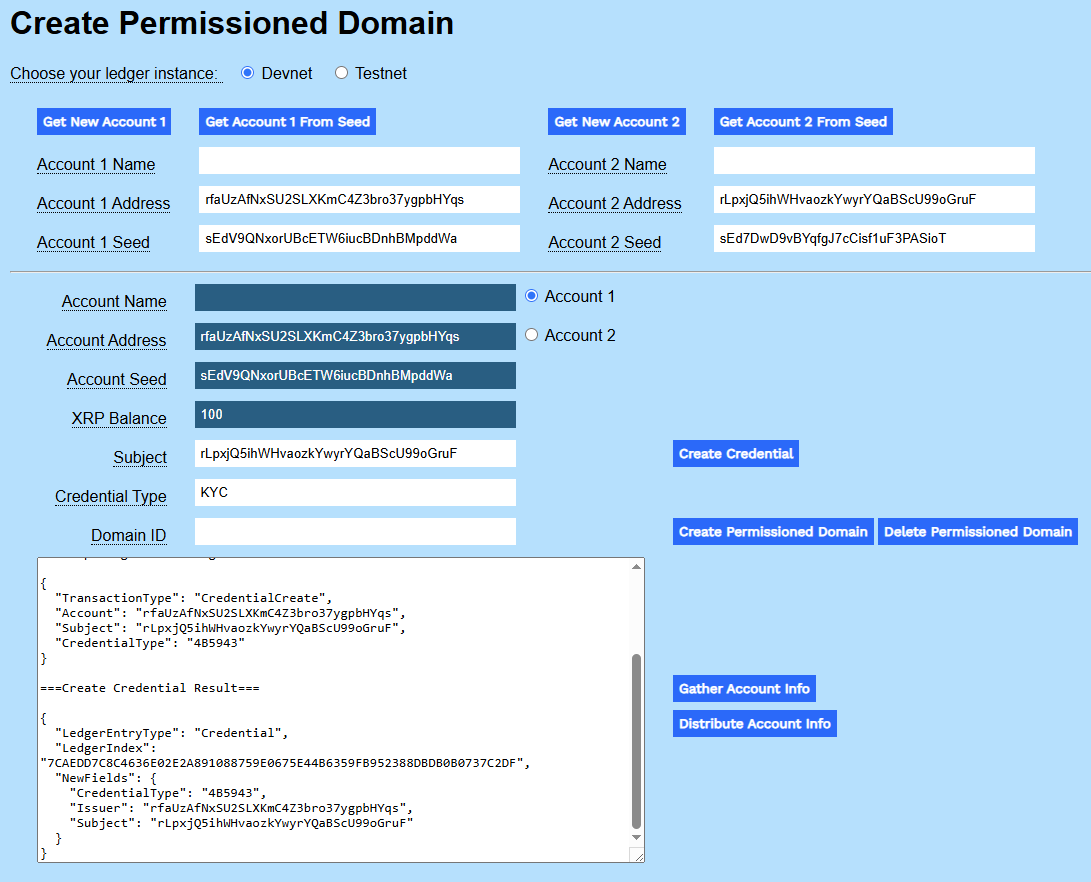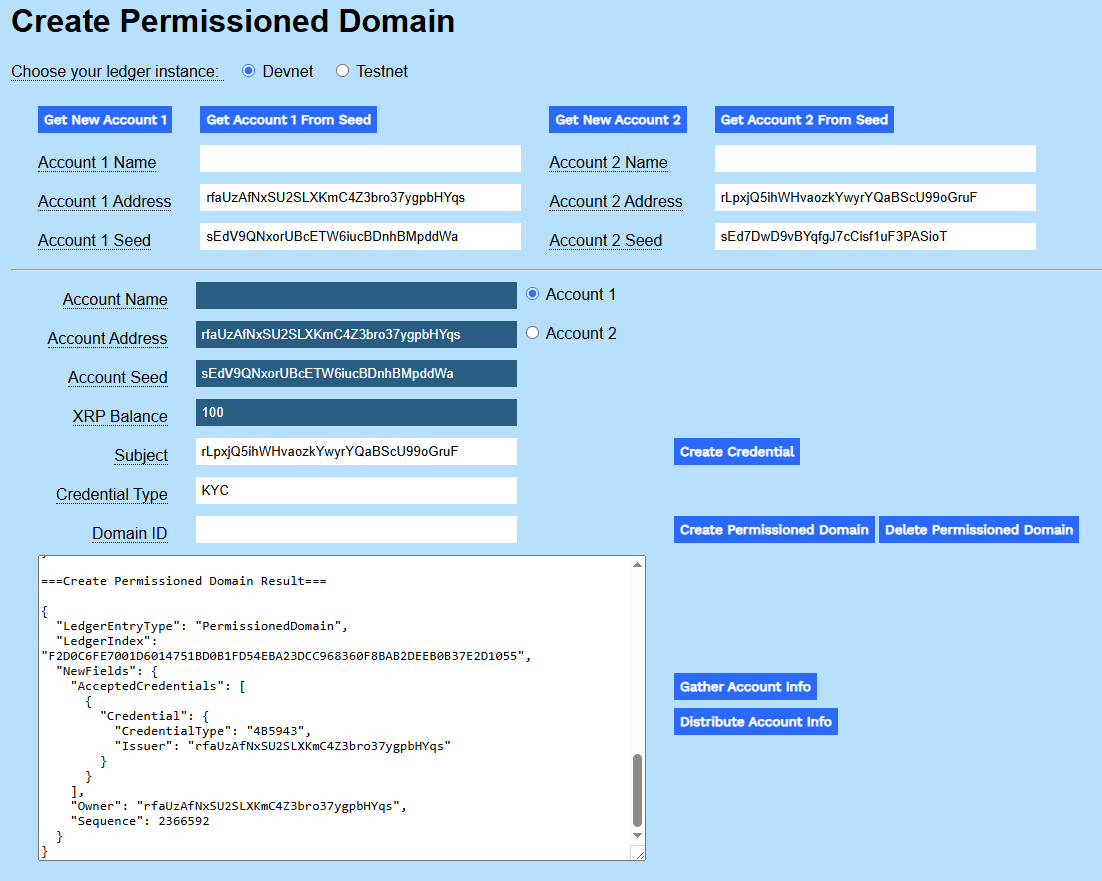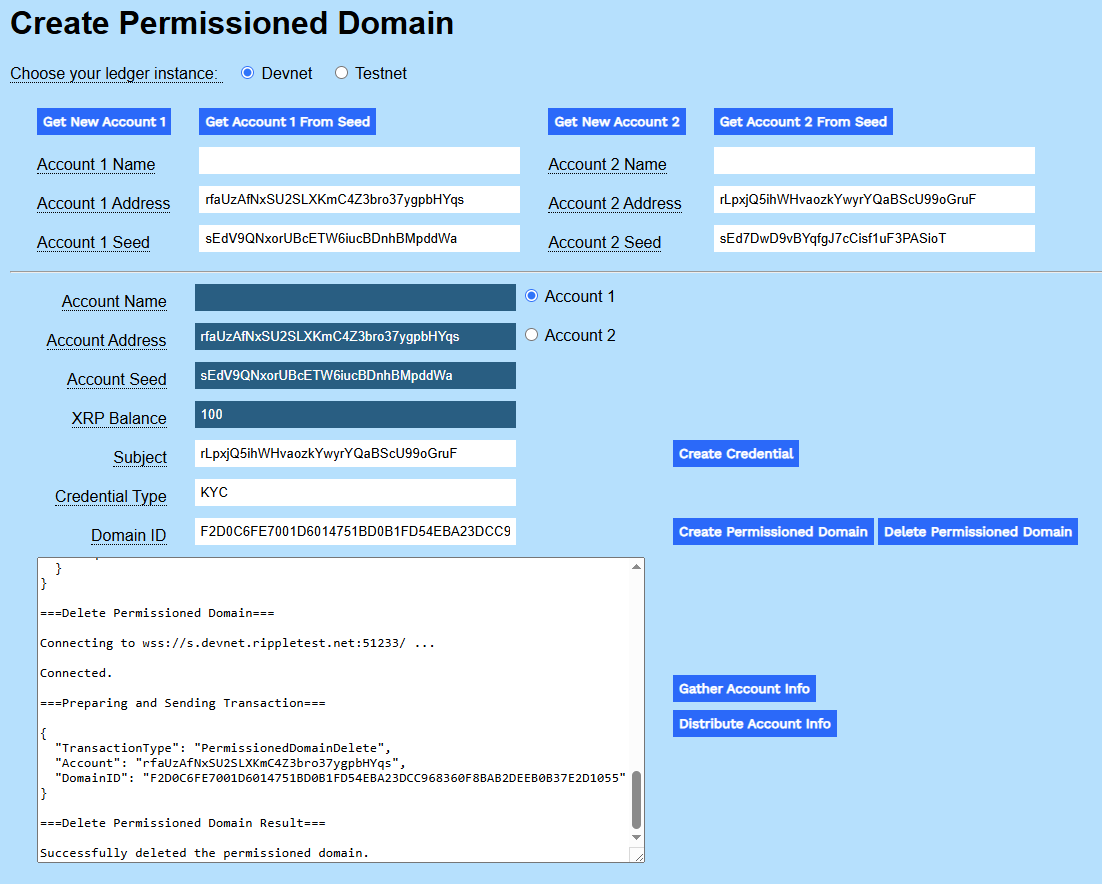Permissioned domains are controlled environments within the broader ecosystem of the XRP Ledger blockchain. Domains restrict access to other features such as Permissioned DEXes and Lending Protocols, only allowing access to them for accounts with specific credentials.
This example shows how to:
- Issue a credential to an account.
- Create a permissioned domain with the issued credential.
- Delete the permissioned domain.
Download the Modular Tutorials folder.
Without the Modular Tutorial Samples, you will not be able to try the examples that follow.
To get test accounts:
- Open
create-permissioned-domains.htmlin a browser. - Get test accounts.
- If you copied the gathered information from another tutorial:
- Paste the gathered information to the Result field.
- Click Distribute Account Info.
- If you have an existing account seed:
- Paste the account seed to the Account 1 Seed or Account 2 Seed field.
- Click Get Account 1 from Seed or Get Account 2 from Seed.
- If you do not have existing accounts:
- Click Get New Account 1.
- Click Get New Account 2.
- If you copied the gathered information from another tutorial:
- Click the Account 1 radial button. This account will be the credential issuer.
- Copy the account 2 address into Subject.
- Enter a Credential Type. For example, KYC.
- Click Create Credential.
- Click Create Permissioned Domain.
- Copy the LedgerIndex value from the metadata response.
- (Optional) Update the permissioned domain with a different credential.
- Change the Credential Type.
- Click Create Credential.
- Copy the LedgerIndex value into DomainID.
- Click Create Permissioned Domain.
- Copy the LedgerIndex value into DomainID.
- Click Delete Permissioned Domain.
Define a function that issues a credential to a subject and connects to the XRP Ledger.
/ Create credential function
async function createCredential() {
let net = getNet()
const client = new xrpl.Client(net)
results = `\n\n===Creating Credential===\n\nConnecting to ${getNet()} ...`
updateResults()
await client.connect()
results = `\n\nConnected.`
updateResults()
Gather the issuer information, subject, and credential type. Convert the credential type value to a hex string if not already in hex. Wrap the code in a try-catch block to handle errors.
// Gather transaction info
try {
// Get account wallet from seed
const wallet = xrpl.Wallet.fromSeed(accountSeedField.value)
// Get subject
const subject = subjectField.value
// Get credential type - convert string to hex if needed
let credentialType = credentialTypeField.value;
if (!/^[0-9A-F]+$/i.test(credentialType)) {
let hex = '';
for (let i = 0; i < credentialType.length; i++) {
const charCode = credentialType.charCodeAt(i);
const hexCharCode = charCode.toString(16).padStart(2, '0');
hex += hexCharCode;
}
credentialType = hex.toUpperCase();
}
// Prepare transaction
const transaction = {
"TransactionType": "CredentialCreate",
"Account": wallet.address,
"Subject": subject,
"CredentialType": credentialType
}
results = `\n\n===Preparing and Sending Transaction===\n\n${JSON.stringify(transaction, null, 2)}`
updateResults()
Submit the CredentialCreate transaction and report the results. Parse the metadata response to return only relevant credential info.
// Submit transaction
const tx = await client.submitAndWait(transaction, {autofill: true, wallet: wallet})
if (tx.result.meta.TransactionResult == "tesSUCCESS") {
// Parse for credential info
const parsedResponse = JSON.parse(JSON.stringify(tx.result.meta.AffectedNodes, null, 2))
const credentialInfo = parsedResponse.find( node => node.CreatedNode && node.CreatedNode.LedgerEntryType === "Credential" )
results = `\n\n===Create Credential Result===\n\n${JSON.stringify(credentialInfo.CreatedNode, null, 2)}`
} else {
results = `\n\n===Error===\n\n${JSON.stringify(tx.result.meta.TransactionResult, null, 2)}: Check codes at https://xrpl.org/docs/references/protocol/transactions/types/credentialcreate#error-cases`
}
updateResults()
} catch (error) {
results = `\n\n===Error===\n\n${error}`
updateResults()
}
client.disconnect()
}Define a function that creates a permissioned domain and connects to the XRP Ledger.
// Create permissioned domain
async function createDomain() {
let net = getNet()
const client = new xrpl.Client(net)
results = `\n\n===Creating Permissioned Domain===\n\nConnecting to ${getNet()} ...`
updateResults()
await client.connect()
results = `\n\nConnected.`
updateResults()
Gather issuer information, credential type, and domain ID. Format the transaction depending on if the optional domain ID field is included. Wrap the code in a try-catch block to handle errors.
// Gather transaction info
try {
// Get account wallet from seed
const wallet = xrpl.Wallet.fromSeed(accountSeedField.value)
// Get Domain ID
const domainID = domainIDField.value
// Get credential type - convert string to hex if needed
let credentialType = credentialTypeField.value;
if (!/^[0-9A-F]+$/i.test(credentialType)) {
let hex = '';
for (let i = 0; i < credentialType.length; i++) {
const charCode = credentialType.charCodeAt(i);
const hexCharCode = charCode.toString(16).padStart(2, '0');
hex += hexCharCode;
}
credentialType = hex.toUpperCase();
}
// Prepare transaction
const transaction = {
"TransactionType": "PermissionedDomainSet",
"Account": wallet.address,
"AcceptedCredentials": [
{
"Credential": {
"Issuer": wallet.address,
"CredentialType": credentialType
}
}
]
}
if (domainID) {
transaction.DomainID = domainID
}
results = `\n\n===Preparing and Sending Transaction===\n\n${JSON.stringify(transaction, null, 2)}`
updateResults()
Submit the PermissionedDomainSet transaction and report the results. The metadata is formed differently if a domain ID is included; parse the response accordingly.
// Submit transaction
const tx = await client.submitAndWait(transaction, {autofill: true, wallet: wallet})
if (tx.result.meta.TransactionResult == "tesSUCCESS") {
// Parse for domain info
if (domainID) {
results = `\n\n===Create Permissioned Domain Result===\n\n${JSON.stringify(tx.result.tx_json, null, 2)}`
} else {
const parsedResponse = JSON.parse(JSON.stringify(tx.result.meta.AffectedNodes, null, 2))
const domainInfo = parsedResponse.find( node => node.CreatedNode && node.CreatedNode.LedgerEntryType === "PermissionedDomain" )
results = `\n\n===Create Permissioned Domain Result===\n\n${JSON.stringify(domainInfo.CreatedNode, null, 2)}`
}
} else {
results = `\n\n===Error===\n\n${JSON.stringify(tx.result.meta.TransactionResult, null, 2)}: Check codes at https://xrpl.org/docs/references/protocol/transactions/types/permissioneddomainset#error-cases`
}
updateResults()
} catch (error) {
results = `\n\n===Error===\n\n${error}`
updateResults()
}
client.disconnect()
}Define a function to delete a permissioned domain and connect to the XRP Ledger.
// Delete permissioned domain
async function deleteDomain() {
let net = getNet()
const client = new xrpl.Client(net)
results = `\n\n===Delete Permissioned Domain===\n\nConnecting to ${getNet()} ...`
updateResults()
await client.connect()
results = `\n\nConnected.`
updateResults()
Gather account information and domain ID values. Wrap the code in a try-catch block to handle errors.
// Get delete domain transaction info
try {
// Get account wallet from seed
const wallet = xrpl.Wallet.fromSeed(accountSeedField.value)
// Get Domain ID
const domainID = domainIDField.value
// Prepare transaction
const transaction = {
"TransactionType": "PermissionedDomainDelete",
"Account": wallet.address,
"DomainID": domainID
}
results = `\n\n===Preparing and Sending Transaction===\n\n${JSON.stringify(transaction, null, 2)}`
updateResults()
Submit the PermissionedDomainDelete transaction and report the results.
// Submit delete domain transaction
const tx = await client.submitAndWait(transaction, {autofill: true, wallet: wallet})
if (tx.result.meta.TransactionResult == "tesSUCCESS") {
results = `\n\n===Delete Permissioned Domain Result===\n\nSuccessfully deleted the permissioned domain.`
} else {
results = `\n\n===Error===\n\n${JSON.stringify(tx.result.meta.TransactionResult, null, 2)}: Check codes at https://xrpl.org/docs/references/protocol/transactions/types/permissioneddomaindelete#error-cases`
}
updateResults()
} catch (error) {
results = `\n\n===Error===\n\n${error}`
updateResults()
}
client.disconnect()
}